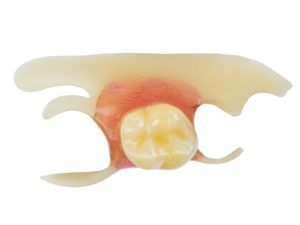 Removable denture A butterfly belongs to a group of temporary dental structures, and is installed only until a permanent prosthesis is made.
Removable denture A butterfly belongs to a group of temporary dental structures, and is installed only until a permanent prosthesis is made.
This type of construction has another name - Immediate prosthesis.
This type of prosthetics has found wide application in dentistry.
Contents of
- What is Immediate Prosthetics?
- prosthesis Specifics of the
- solution Indications and contraindications for the
- installation
- 's manufacturing and installation process Advantages and disadvantages
- Lifetime
- From the practice of the patients
- Expert opinion
- Question price
What is implied prosthesis?
Butterfly is a removable temporary structure that is used to fix it next to the removed tooth for the period of manufacturing the basic prosthesis, most often this prosthesis is installed on one tooth, more rarely by two.
Looks like an ordinary immediate tooth, on the sides of which are special fasteners in the form of "wings".It is because of this form that the prosthesis has received such a name.
The temporary tooth protects the gums from damage in the area where the tooth was removed. It also performs an aesthetic function. 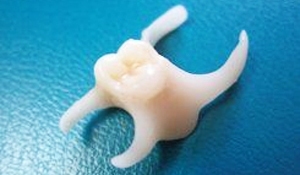
It is used in the event that in future it is planned to install a crown or an implant( usually on the front tooth).
It is often used to remove the gap on the front teeth, as the latter can bring moral suffering, especially for the fairer sex, for whom external beauty plays an important role in life.
Types of prosthesis
Despite the limited use of this design, the butterfly prosthesis is divided into two types:
- for partial prosthetics;
- for complete prosthetics.
The first type of prosthesis is used if it is necessary to close the lumen in order to keep healthy adjacent teeth in place for the period that a permanent prosthesis or crown is being made. The second, in turn, is a replacement of the whole dentition and is used in the preparatory stage before the installation of a permanent prosthesis.
The material from which butterflies are made is also different. They can be nylon and acrylic. Prosthes made of nylon are characterized by special softness, flexibility and lightness. Acrylic are more natural, and also cheap.
Recently, the popularity began to recruit immediata and soft hypoallergenic plastics.
Features of the
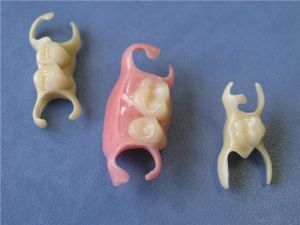 solution In modern dentistry, two types of constructions are used, which differ from each other with the material of the clasps. They can be made of metal or plastic. In the first case, you need to be prepared for the fact that you will be able to see them when you smile. However, they are often chosen because of their reliability.
solution In modern dentistry, two types of constructions are used, which differ from each other with the material of the clasps. They can be made of metal or plastic. In the first case, you need to be prepared for the fact that you will be able to see them when you smile. However, they are often chosen because of their reliability.
With regard to plastic holding hooks, the prosthesis with them can be applied both to the retaining teeth and to the areas of the oral mucosa that adjoins the defect site directly.
In addition, some designs have a slight extension of the base, which adjoins the sky from the back of the dentition.
The area of this part is very small, but serves to increase the stability of the prosthesis. This is facilitated by the use of a special fixing cream.
Indications and contraindications for the installation of
The use of a butterfly is recommended in the following situations:
- if necessary to restore the chewing function of the tooth, but remember that too hard food can damage the prosthesis;
- for the preservation of soft tissues after the operation of tooth extraction, as a result of which they will not be needed for the installation of a permanent prosthesis;
- for the reconstruction of the integrity of the dentition, which will enhance the aesthetics of a smile;
- when there is a need to replace the missing tooth in order to conserve the nearby organs, due to the presence of periodontal disease;
- when preparing soft tissue for the installation of a permanent implant( it is not always possible to do this immediately after tooth extraction).
As such, there are no contraindications to the installation of an immediate, but there are factors that can prevent it, and these are purely technical characteristics of the oral cavity:
- jaw bone deformities that can be both congenital and acquired;
- destroyed adjacent teeth, which is why there is no possibility of fixing the prosthesis.
There is no negative effect on the body of the prosthesis.
How the process of manufacturing and installation of the
goes The whole process takes place in several stages, and the doctor clearly observes the maximum accuracy in the calculations, otherwise the prosthesis simply does not fit in the place prepared for it.
The main stages of manufacturing are:
- Removing an impression from a healthy tooth, all the requirements for its size are required. The impression is made before the removal of the damaged tooth from the
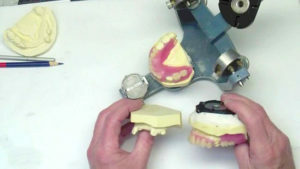 .The decision to install a temporary prosthesis is taken during this period.
.The decision to install a temporary prosthesis is taken during this period. - Making technicians an exact copy of the removed tooth on the impression that the doctor gave them. Used for this nylon, acrylic or plastic, as well as forming a fastener( for this removes the impression of neighboring healthy teeth).
- After the manufacture of , the prosthesis is not immediately installed in place of the .The dentist first tries on fitting, since it always requires adjustment according to the current situation( during the manufacturing period, changes in the patient's oral cavity may occur).
The prosthesis is absolutely not felt by the patient. In the course it is not demanding, it is easy to remove it for cleaning yourself.
If the prosthesis is made to replace several teeth at once, the work is almost identical, but the attention that the dentist makes to the teeth that support the prosthesis should be more intimate.
If they are problematic, discomfort may occur during the wearing of the prosthesis. To correct the situation will help the use of temporary prosthesis made of nylon, because it is more flexible and soft.
Advantages and disadvantages of
The obvious advantages of this type of prosthetics are:
safety for adjacent teeth, since they remain completely untreated( neither before the crown installation nor during fitting of the prosthesis form), all manipulations are performed with the prosthesis itself;
- high aesthetics due to the naturalness of the artificial tooth( it can be seen only if metal is used in the manufacture of the klyamers);
- production speed: the whole process takes several days( the first visit is made an impression, the second - the patient is already installed prosthesis, with the use of cast frame may require an additional fit);
- can be used as a temporary( for wound healing after tooth extraction and before planned implantation, which is delayed for a certain period of time) and permanent construction, and the prosthesis can be made even before the tooth is removed, which will allow using it immediately after manipulation( this will allow the patient not toto experience the discomfort that occurs when there is a lumen);
- possibility of use in diseases of gums;
- hypoallergenicity;
- ease of use;
- easy care;
- is a small cost;
- long service life.
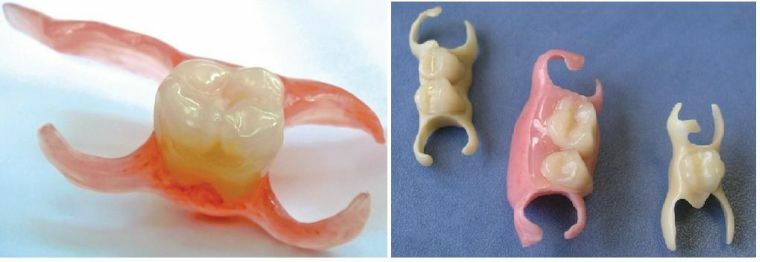
Despite a large number of obvious advantages, do not forget about the shortcomings. Although they are much smaller, they can influence the choice.
In particular, the disadvantages are:
- use of metal hooks( this design is made when plastic clamps are unable to firmly fix the prosthesis on adjacent teeth);
- inadequate fixation( observed very rarely due to individual features of the jaw structure).
In any case, the decision on the appropriateness of using a prosthesis is taken only by the doctor on the basis of the examination and subsequent treatment.
Lifetime
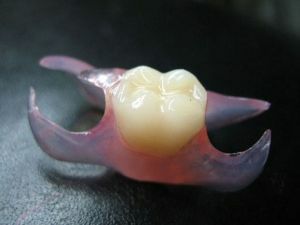 Typically, this design is used as a temporary measure. That is why, those materials that are used in the manufacture of the Butterfly prosthesis are chosen in such a way that the patient does not feel discomfort during his wearing.
Typically, this design is used as a temporary measure. That is why, those materials that are used in the manufacture of the Butterfly prosthesis are chosen in such a way that the patient does not feel discomfort during his wearing.
The service life depends on the time of manufacturing permanent implants and can vary from two weeks to six months. However, these prostheses can be used for much longer.
While wearing this temporary prosthesis design, it is easy to maintain oral hygiene, as it can be removed and put on independently.
From the practice of patients
Dental prosthesis Butterfly is very popular in dentistry, which is confirmed by numerous reviews of patients.
After the car accident, I lost part of the front tooth. All would be nothing, but I had to be a witness at the wedding of a best friend. And, naturally, in this form, I could not appear there. Turning to a dental clinic, the doctor advised me a removable denture butterfly. Made it pretty quickly, no unpleasant sensations were not immediately. He just saved me.
Irina, 23 years old
I almost never had any problems with my teeth, I went to the dentist only for preventive examination. But then problems with one of the incisors began. Treatment took a lot of time, effort and money, but in the end it was still deleted. There is no money for the implant, the doctor advised him to put the immediate on time. And I never regretted it. Convenient and very inexpensive.
Svetlana, 47 years
Expert opinion
Many patients refuse removable dentures, arguing that there is a feeling of discomfort and the need to clean them daily. But in reality this is not so. If the prosthesis is made in accordance with the size of the jaw, there are no unpleasant sensations. This is facilitated by the use of soft materials, such as nylon or soft plastic.
Valery Leonidovich, work experience 9 years
Price
The cost of manufacturing and installing butterflies in different clinics is different, and can range from 5.5 to 25 thousand rubles. The price depends on the prestige of the clinic, the level and professionalism of the dentists and dental technicians working in it.
As for the materials used, it is possible to reduce the cost by replacing the plastic with the metal when making hooks.
This cost is not considered low for temporary prosthesis, but many patients can wear it for years, which significantly reduces the cost of construction.
